
 |
| [ ASCILITE ]
[ 2004 Proceedings Contents ] |
Considerable research has indicated the importance of having a sound pedagogical framework in place for the creation of learning objects which can support student learning, particularly higher order thinking skills. This paper describes the evolution of a learning object that has been in use for nearly eight years. The interactive graphing object (IGO) is a reusable learning object (RLO) that supports students to develop a deeper understanding of concepts that can be expressed graphically. Previous research indicated that the IGO facilitates higher levels of student engagement and deeper approaches to learning than more conventional static displays or animations of graphs. However, the student learning environment continues to evolve and diversify. There is a need for the development of RLOs that can keep pace with these changes. Some limitations with the original authoring environment which prevented more widespread use of the IGO have been addressed. Moreover, the advent of more powerful Personal Digital Assistants (PDAs) has resulted in the redesign of the student environment of the IGO, and development of a mobile form of the IGO-the mIGO. This paper discusses the design and development issues associated with improving a successful RLO, and then adapting it to facilitate learning in a mobile environment.
None of the growth in the power of computers or PDAs has negated the requirement to develop learning environments and learning tools that are pedagogically sound. Placing content on the web or storing it in a Learning Management System (LMS) is not sufficient for learning to occur (Ehrmann, 1995; Reeves, 2003; Rehak & Mason, 2003). There is still a need for learning tools that by design more readily support instructors in their quest to match the student learning outcomes with appropriate activities, assessment and feedback. Reusable learning objects (RLOs) may help to close the gap between what lecturers say they want as student learning outcomes and the mechanisms by which lecturers are currently able to provide feedback and support deeper approaches to learning (Biggs, 1989).
Graphs are widely used to explain relationships between variables and are often fundamental to the understanding of key concepts in science, business and medical sciences. It seems reasonable then to develop a RLO that enables students to articulate knowledge directly by sketching a graph onscreen rather than watching an animation or looking at a static image. The Interactive Graphing Object is an RLO that supports direct sketching of graphs on a computer and has stood the test of time. Originally the IGO was named the Interactive Graphing Tool (IGT) and developed to enable lecturers to develop questions (and provide feedback to students) that linked different representations of knowledge. The initial work focused on undergraduate chemistry for exemplars, but the IGO was suitable for any domain that had similar requirements. In chemistry the IGO was described thus:
The interactive graphing tool (IGT) has been designed and used within a framework that links the literature on student learning to that on understanding symbolic representations of chemical phenomena. The IGT is an educational tool which is designed to actively engage students in constructing relationships between macroscopic properties of matter and the symbolic representations used by chemists to represent those processes. (Kennedy, Fritze & McTigue, 1997, p. 331)In the initial design development phase it was realised that the IGT could be used in domains other than chemistry (e.g., physics, business, pharmacy and medicine). The range of curves recognised by the software algorithm is common to a variety of academic disciplines. Academic staff members from different faculties were interviewed during the design phase to ensure that the curves recognised by the software would satisfy (some of) the learning needs specific to the use of graphs in their discipline. For the remainder of the paper, the term IGO will be used to represent both iterations of the learning object.
The IGO has been designed from a constructivist perspective. It is intended to support higher order thinking and greater student activity than conventional static or animated versions of graphing tools available on the Internet (a search of Google will produce a large number of Java applets or Flash movies (.swf files) that create graphs or animations of graphs in a many subjects). When using the IGO a student has to make a significant number of decisions before sketching an answer. For example (depending upon the nature of the question):
In summary, the IGO required students to sketch a graph directly on the screen with a mouse. The software algorithm was designed to respond to a wide range of common graph types including logarithmic, exponentials, curves, straight lines, and combinations of these curves. The second iteration of the IGT is the IGO, while the third (but closely connected) iteration is the Mobile Interactive Graphing Object (mIGO). The following section is provided to indicate the manner in which the IGO provided customised feedback to different student inputs.
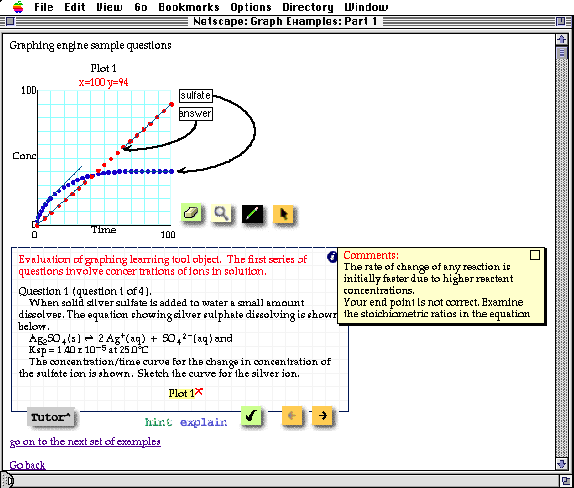
Figure 1: Screen capture of the initial Interactive Graphing Tool (1997)
The original software was developed in Macromedia Director and implemented as a Shockwave object in a web page. Using the web environment enabled a wide variety of content (media) to be used in conjunction with questions. For example, lecturers could ask students to watch a video of a process and then estimate or describe the process graphically, effectively encouraging students to link macroscopic properties of matter with the symbolic representations-traditionally a difficult task. Figure 1 shows a version of the IGO with an example from chemistry. In Figure 1 the answer (the straight line) has resulted in two components of feedback related to the shape of the curve and the end point. The potential to provide multiple forms of feedback has been highlighted by students as a strength of the pedagogical design of the IGO.
Two screen captures in Figure 2 show how the IGO provides multiple forms of feedback depending upon student input. In the first part of Figure 2 none of the student information is correct and there are three sentences providing feedback. In the second example only one sentence is needed to provide adequate feedback to the student. The message in the Comments (feedback) box has changed in response to the new input. Clearly, the quality of the feedback provided will be determined by the lecturer.
| In this example the student has little knowledge of how the graphical relationship of the silver ion concentration changes. The feedback is detailed and addresses the start points, end points and the shape of the curve-all key factors in relating the process to the graphical representation. | 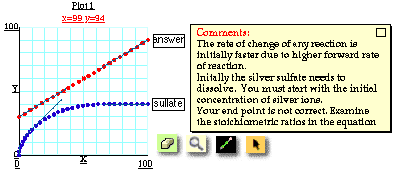 |
| In this image the student answer has modified to include the correct start point and the shape of the graph. The feedback provided focuses on the importance of the end point for the graph-a key chemical concept. | 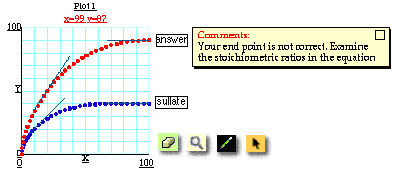 |
The IGO is a stable tool and is still in use at The University of Melbourne without further significant development. Student evaluations of the IGO continue to be positive. For example, it has been integrated with several other online learning tools in a collaborative learning environment in physiology (Kemm et al., 2000). Figure 3 provides a screen capture of the IGO in 2002. In 2003 funding was obtained from the LEARNet fund (Hong Kong University) for the redevelopment of the IGO. This provided the opportunity to develop a more robust, user friendly, authoring environment and extend the functionality of the new RLO. Figure 4 is a current version of the IGO (authoring mode).
The authoring environment is entirely forms based.. The curve parameters are set by sketching a shape with the mouse and then typing in the desired feedback. The authoring environment is complete. A number of changes were made to the interface after discussion with peers resulting in a more user friendly screen. The lecturer creates a question and then clicks, 'Save' (Figure 4). A file that encapsulates the entire question is created ready for upload to a web server for either the PDA or a web browser. There are still significant differences between the output for the web or the PDA. This is discussed in the next section.
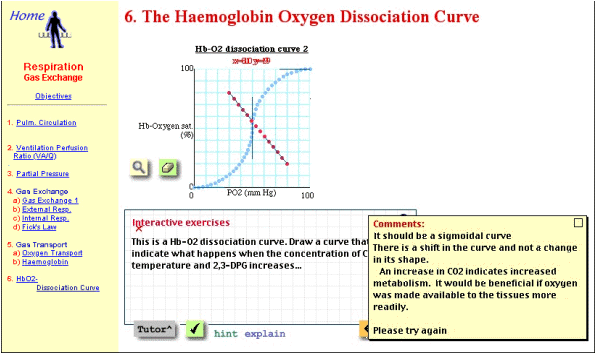
Figure 3: IGO as used in physiology collaborative learning environment (2002)
The IGO has been redeveloped in Java (a Java Applet) which enables a number of significant enhancements, particularly in regard to authoring. Java was selected as the programming language to undertake the redevelopment because it is:
All curves drawn by the IGO, including logarithmic and exponential shapes can be simulated by a Bˇzier curve. In the current web version and the mIGO version the 'handles' of the Bˇzier curve can be shown by the lecturer and the student. This enables feedback provided by the lecturer to be more quantitatively based than previously possible.
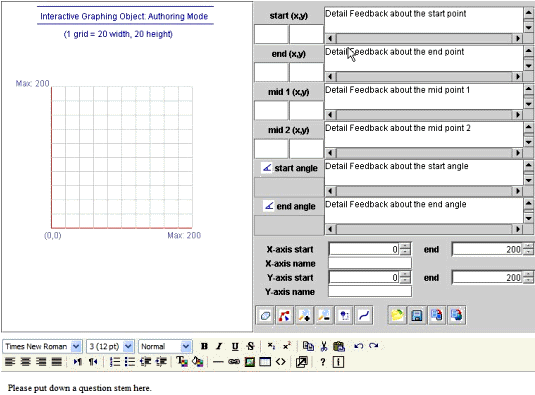
Figure 4: The IGO authoring mode (2004)
Mobile devices currently have the power to run a large number of applications, especially those with task sharing options. However, there are considerable challenges associated with using mobile devices for learning. The current generation of mobile devices are still limited by several inhibiting factors that prevent people from initiating use of mobile devices or limit their current usability (Csete, Wong & Vogel, 2004). These include:
| Inhibitors | Relationship to current mIGO functionality | Future Solution |
| Small screen size | This is an issue and has resulted in the need to have an overlapping pop-up with the feedback to questions | Flexible film display |
| Non-ergonomic input method | The stylus is used for data input and is simple to use, and appropriate for the task required - sketching a graph | Voice recognition Projection keyboard Cursive handwriting recognition |
| Slow CPU speed | The mIGO is a small RLO and the speed of operation for curve fitting and feedback is acceptable. | New breed of architecture for faster CPU |
| Limited memory | The standard memory in most PDAs is more than sufficient to run the mIGO | Expansion memory card Increase internal RAM capacity |
| Limited battery span | This remains an issue for extended use | New breed of lithium battery |
| Ever changing OS | Currently, a proprietary system is used, however this could change with time and recent developments in open source solutions for the PDA | Generic OS on PDA, mobile phone and smartphone |
| Infrastructure compatibility | This is improving very rapidly. The plethora of wireless networks being created world wide has an astonishing rate of growth and PDAs are often equipped with more than one method of wireless connectivity | Middleware to bridge the mobile and LAN platform |
| Connectivity bandwidth | This is adequate for the mIGO, with bandwidth sufficient. | 3G mobile capacity Bluetooth v.1.2 |
However, even if all of the technological inhibitors were to magically disappear, we must still recognise that mobile devices will continue to present application challenges as variety increases and trends towards 'smaller and lighter' sustain e.g., in 'smart phones', etc. Simply porting applications from traditional computing environments is not a viable solution either in the present or the future. Human computer interface and host coupling issues are particularly salient. The stylus driven interface of mobile devices and limited real estate encourage rethinking layouts to make maximal use of available screen space and device characteristics.
The current mIGO interface is illustrated in Figure 5. The degree of compaction becomes immediately apparent in comparison to the original and current web based IGO illustrated in Figures 1-4. As described in Figure 5, icons have been designed and clustered to support both and local and host connectivity functions.
Student feedback occurs in a pop-up window overlaying a portion of the painting canvas. Not withstanding the limitations of the mobile environment (Table 1) the mIGO functions very well, with curve matching and feedback presentation almost instantaneous. The stylus is also a very effective and appropriate input device for this type of RLO. The use of the curve handles allows a high degree of accurate placement of key curve parameters.
Beyond the human computer interface must be the consideration of host coupling and integration with base stations to effectively interact with mobile devices. As previously mentioned, development of a flexible capability for instructors to create applications with authoring mode support is an important consideration. As such, a host environment is created that enables material to be refreshed and made available to the students. Of concern is the degree to which the mobile devices operate independently and whether both uploading and downloading are supported to enable instructor monitoring. The limited capacity of mobile devices requires periodic connection to a host. However, the sometimes 'spotty' wireless connectivity domain encourages that mobile devices be able to work offline to enable maximal user independence.
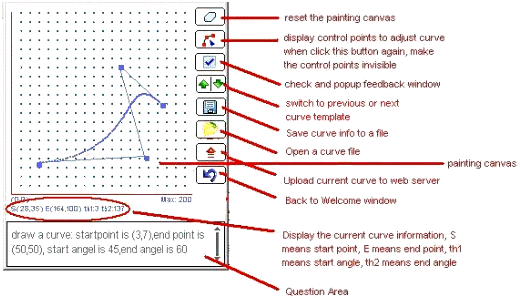
Figure 5: The mIGO (2004)
In its current implementation, the mIGO downloads a limited set of questions and responses to enable the students to work offline, store results locally and re-connect to the base station only when new questions are desired. Although the focus is on formative learning use by the student, the capability also exists for results to be uploaded to the host.
A broad range of staff development issues and challenges exist to assure that the applications are appropriately integrated into course activities and curricula and generally encourage extended student use. Some instructors are naturally drawn into trying new approaches to learning. Unfortunately, many are not and remain especially apprehensive about new technologies that might require large amounts of effort or upset established ways of course conduct. Professional support as well as collaboration among instructors is required to create a critical mass and expand acceptance. Encourage for sharing and creating repositories of learning objects becomes paramount to expanded application. This requires a cultural shift as instructors have to think beyond their immediate domain to creating learning objects that don't become shelf ware or their own personal closely held bit of support. Management sensitivity to providing incentives and support needs to be initiated.
From an institutional perspective, a variety of readiness and integration issues need to be addressed to minimise barriers to use and help assure program success. Having a portfolio of both administrative and coursework applications that support a wide range of student needs and interests running on a mobile device helps ensure sustained use. Institutional portals need to be mobile sensitive in facilitating access and providing compatible support. For example, web page content needs to be formatted such that it can be reasonably viewed on mobile devices. This is not a problem, as can readily be seen by looking at news sites (e.g., http://www.cnn.com), but does require consideration and layout attention on the host site. This often entails expanded consideration of website objectives, requirements and delivery modes. Additional attention needs also to be given to telecommunications infrastructure to assure reliable access to institutional resources with sufficient bandwidth to avoid frustrating mobile device users.
Csete, J., Wong, Y.-H. & Vogel, D. (2004). Mobile devices in and out of the classroom. In L. Cantoni & C. McLoughlin (Eds.), ED-MEDIA 2004, (pp. 4729-4736). Proceedings of the 16th World Conference on Educational Multimedia and Hypermedia & World Conference on Educational Telecommunications, Lugano, Switzerland:, Norfolk VA: Association for the Advancement of Computing in Education.
Ehrmann, S. C. (1995). The bad option and the good option. The Educom Review, 30(5, Sept/Oct), 41-43. http://www.educause.edu/apps/er/review/reviewArticles/30541.html
Green, K. (2004). The 2003 National Survey of Information Technology in US Higher Education. The Campus Computing Project. http://www.campuscomputing.net/ [viewed 29 July 2004]
Kemm, R. E., Kavnoudias, H., Weaver, D. A., Fritze, P. A., Stone, N. & Williams, N. T. (2000). Collaborative learning: An effective and enjoyable experience! A successful computer-facilitated environment for tertiary students. In J. Bourdeau & R. Heller (Eds.), ED-MEDIA 2000, (pp. 9-20). Proceedings of the 12th annual World Conference on Educational Multimedia, Hypermedia & Telecommunications, Montreal: Charlotteville: Assocation for the Advancement of Computers in Education.
Kennedy, D. M. (2004). Continuous Refinement of Reusable Learning Objects: The Case of the Interactive Graphing Object. In L. Cantoni & C. McLoughlin (Eds.), ED-MEDIA 2004, (pp. 1398-1404). Proceedings of the 16th World Conference on Educational Multimedia and Hypermedia & World Conference on Educational Telecommunications, Lugano, Switzerland: Norfolk VA: Association for the Advancement of Computing in Education.
Kennedy, D. M., Fritze, P. & McTigue, P. (1997). An Interactive Graphing Tool: The meeting of pedagogy and technology. In R. Kevill , R. Oliver & R. Phillips (Eds.), What works and why: ASCILITE 97, (pp. 331-337). Proceedings 14th ASCILITE Conference, Curtin University of Technology, Perth. http://www.ascilite.org.au/conferences/perth97/papers/Kennedy/Kennedy.html
Kennedy, D. M., McNaught, C. & Fritze, P. (2004). Conceptual tools for designing and learning. In P. Kommers (Ed.), Cognitive support for learning: Imagining the unknown (pp.141-154). Amsterdam: IOS Press.
Reeves, T. C. (2003). Storm clouds on the digital education horizon. Journal of Computing in Higher Education, 15(1), 3-26.
Rehak, D. R. & Mason, R. (2003). Keeping the learning in learning objects. In A. Littlejohn (Ed.), Reusing online resources: A sustainable approach to e-learning. London: Kogan Page Ltd.
The Office of the Telecommunications Authority of Hong Kong. (2004). Key Telecommunications Statistics: May 2004. The Office of the Telecommunications Authority of Hong Kong, http://www.ofta.gov.hk/datastat/eng_key_stat.html [viewed 1 Aug 2004, verified 15 Oct 2004].
| Authors: David M. Kennedy, Department of Information & Applied Technology. Hong Kong Institute of Education, Hong Kong. kennedy@ied.edu.hk Douglas R. Vogel & Tomson Xu, Department of Information Systems, City University of Hong Kong, Hong Kong. isdoug@cityu.edu.hk and tomsonxu@cityu.edu.hk Please cite as: Kennedy, D.M., Vogel, D.R. & Xu, T. (2004). Increasing opportunities for learning: Mobile graphing. In R. Atkinson, C. McBeath, D. Jonas-Dwyer & R. Phillips (Eds), Beyond the comfort zone: Proceedings of the 21st ASCILITE Conference (pp. 493-502). Perth, 5-8 December. http://www.ascilite.org.au/conferences/perth04/procs/kennedy.html |
© 2004 David M. Kennedy, Douglas R. Vogel and Tomson Xu
The authors assign to ASCILITE and educational non-profit institutions a non-exclusive licence to use this document for personal use and in courses of instruction provided that the article is used in full and this copyright statement is reproduced. The authors also grant a non-exclusive licence to ASCILITE to publish this document on the ASCILITE web site (including any mirror or archival sites that may be developed) and in printed form within the ASCILITE 2004 Conference Proceedings. Any other usage is prohibited without the express permission of the authors.